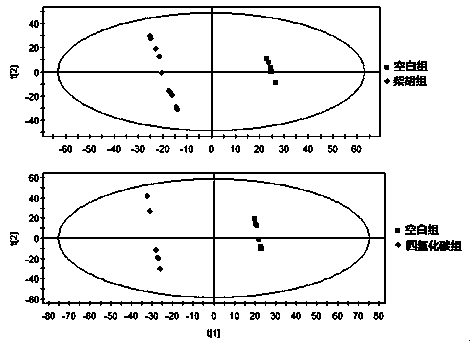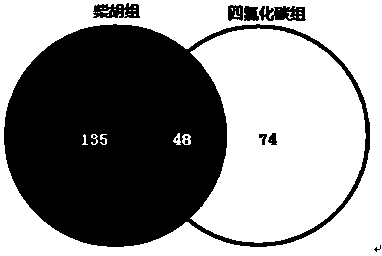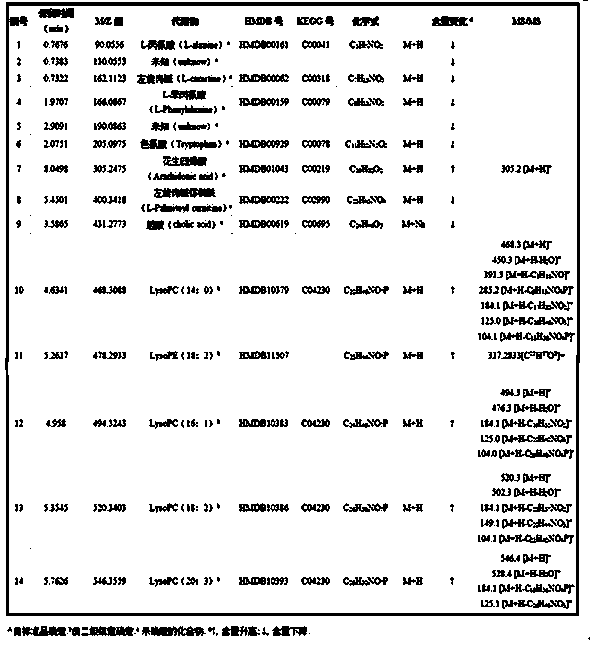Application of endogenous small-molecular substances in rapid detection of hepatotoxicity
A small molecular substance, endogenous technology, applied in the direction of measurement devices, material separation, analysis of materials, etc., can solve the problems of lack of specificity and sensitivity, and can not detect liver damage in time, and achieve the effect of making up for limitations
- Summary
- Abstract
- Description
- Claims
- Application Information
AI Technical Summary
Problems solved by technology
Method used
Image
Examples
Embodiment 1
[0026] 1. Reagents: Acetonitrile was purchased from Oceanpak (Gothenburg, Sweden), and formic acid was purchased from ROE (USA), both of analytical grade. Purified water was purchased from Wahaha Company (Hangzhou, China). Normal saline was purchased from Qidu Pharmaceutical Co., Ltd. (Shandong, China). Gentamicin, etimicin, isoproterenol, 5-fluorouracil, Bupleurum and carbon tetrachloride were purchased from Silan Science and Technology Co., Ltd. (Tianjin, China). Drugs were formulated with physiological saline and given to animals.
[0027] 2. Animal experiments: Animal experiments were conducted at the Institute of Biomedical Engineering, Chinese Academy of Medical Sciences (Tianjin, China). Seventy male Wistar rats (200 ± 20 g) were maintained in an SPF grade laboratory. After the rats were purchased, they were reared under controlled environmental conditions of 12 hours of day and night alternation, an ambient temperature of 25±1° C., and an ambient humidity of 50±5%. ...
Embodiment 2
[0036] Screening method for liver toxicity biomarkers based on metabolomics technology combined with SVM, including: sample pretreatment, data collection, data processing (multivariate statistical analysis), specificity investigation of biomarkers, verification and optimization of specific biomarkers and other steps. It is characterized in that: gradient elution conditions are used in data collection: 0-0.5 min, A: 99%-99%; 0.5-2 min, A: 99%-50%; 2-9 min, A: 50% -1%; 9-10 min, A: 1%-1%; 10-10.5 min, A: 1%-99%; 10.5-12 min, A: 99%-99%, where mobile phase A refers to 0.1% Formic acid in water, mobile phase B refers to 0.1% formic acid in acetonitrile; MATLAB R2010a software (USA) was used in the verification and optimization of exclusive biomarkers to establish an SVM prediction model based on liver toxicity biomarkers, the process is as follows: biomarkers The peak area in the normal saline group and each drug group is used as the input variable, and the data are randomly sele...
Embodiment 3
[0038] Practical application:
[0039] We thawed the collected serum at room temperature for detection of aspartate aminotransferase (AST) and alanine aminotransferase (ALT) in serum. The results showed that compared with the control group, the biochemical indicators in the Bupleurum group and the carbon tetrachloride group all had significant changes (P Figure 6 . This situation occurs because ALT is not a substance unique to the liver, it also exists in the heart tissue, so when the heart tissue is damaged, the ALT value increases. It can be seen that ALT is not specific for the detection of liver. In contrast, the specific biomarkers of hepatotoxicity that we discovered through metabolomics combined with SVM have strong sensitivity and specificity. It can be better used for the prevention, discovery and treatment of liver toxicity, make up for the limitations of existing indicators, and provide accurate detection information in a timely manner.
[0040] The specifi...
PUM
 Login to View More
Login to View More Abstract
Description
Claims
Application Information
 Login to View More
Login to View More - R&D
- Intellectual Property
- Life Sciences
- Materials
- Tech Scout
- Unparalleled Data Quality
- Higher Quality Content
- 60% Fewer Hallucinations
Browse by: Latest US Patents, China's latest patents, Technical Efficacy Thesaurus, Application Domain, Technology Topic, Popular Technical Reports.
© 2025 PatSnap. All rights reserved.Legal|Privacy policy|Modern Slavery Act Transparency Statement|Sitemap|About US| Contact US: help@patsnap.com



